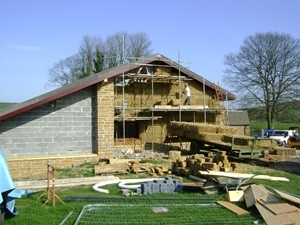 One year after opening the GWCT’s Allerton Project’s award-winning eco-visitor and training centre, researchers from the Game & Wildlife Conservation Trust have been doing the maths to prove that by combining modern technology with traditional materials like sheep fleece and straw, it is possible to create a sustainable rural building that not only has a very low carbon footprint but also saves many thousands of pounds in running costs.
One year after opening the GWCT’s Allerton Project’s award-winning eco-visitor and training centre, researchers from the Game & Wildlife Conservation Trust have been doing the maths to prove that by combining modern technology with traditional materials like sheep fleece and straw, it is possible to create a sustainable rural building that not only has a very low carbon footprint but also saves many thousands of pounds in running costs.
Dr Alastair Leake, from the Game & Wildlife Conservation Trust explains, “We were delighted to scoop the 2012 Property and Construction Award for sustainable development. However, the proof of the pudding was to show how sustainable our converted farm building is in practice and the results are truly impressive. The concept is proving that it is not only good for our farm’s pockets it is also very good for the environment.”
The newly converted farm building, designed by architect Sylvester Cheung, was formerly a derelict cattle shed. It now houses a state-of-the-art training and visitor centre for this leading research charity, which has an enviable track record of demonstrating how wildlife and modern commercial farming can both thrive side by side
Since opening the centre in June 2012 nearly 2,000 visitors have attended briefings and events, ranging from policy makers and government officials to farmers and industry specialists.
Materials used in the construction and for running the building were sourced from the fields of the Allerton Project farm, including straw for the walls and sheep fleece for insulation. Wood chip harvested from the estate’s own woodland provide fuel for the biomass boiler to heat the hot water and the thermostatically zoned under-floor heating. Rainwater is collected for the toilets and showers, while sixteen roof-mounted solar photovoltaic panels provide electrical power to the building.
Dr Leake, explains, “The results are really surprising and have far surpassed our original vision. Our wood chip fuelled biomass boiler, provides our heating and hot water supply, and this has cost us just £225 to run whereas the equivalent amount of oil needed throughout the year would have amounted to nearly £3,500. Our financial savings are therefore considerable and our CO2 emissions have been cut by 13.8 tonnes, as well as providing increased motivation to actively manage our woodlands, which also benefits wildlife.
"In addition, the solar panels have generated 5,930kw of electricity creating a saving of more than £700 in power costs. The bonus is that we have also made a handsome profit of £2,490 as we have sold excess electricity generated back to the national grid through a feed-in tariff arrangement contributing a further reduction in CO2 emissions of 3.11 tonnes."
Constructing this sustainable farm building was not plain sailing as Alastair explains; “Although at times this project was challenging, a year on and we are now reaping the benefits. We have a wonderfully efficient training and visitor centre and the sheep fleece and straw walls keep the building warm in winter and cool in summer. Compared to other buildings our costs are negligible and we are having a minimal impact on the environment through a reduction of CO2 emissions. We have also proved that investment in the countryside need not be neglected and that sustainable rural developments are an achievable aim.”
The virtually zero running costs and the special design features of this award-winning conversion have already generated interest from a global audience. As a result, the GWCT has published a blueprint for sustainable farm buildings. This free guide contains invaluable information on the products and systems used in the development of the building. For printed or pdf copies, please contact Daniel O’Mahony on 01425 651060 or email:domahony@gwct.org.uk.
END
Photocaption: Many of the materials used in the construction and for running the new eco-visitor centre are sourced from the fields of the Allerton Project’s farm, including straw for the walls and sheep fleece for insulation. Woodchip harvested from the estate’s own woodland provide fuel for the biomass boiler.
Notes to editors
The Game & Wildlife Conservation Trust is an independent wildlife conservation charity which carries out scientific research into Britain’s game and wildlife. We advise farmers and landowners on improving wildlife habitats. We employ 22 post-doctoral scientists and 40 other research staff with expertise in areas such as birds, insects, mammals, farming and statistics. We undertake our own research as well as projects funded by contract and grant-aid from Government and private bodies. The Trust is also responsible for a number of Government Biodiversity Action Plan species and is lead partner for grey partridge and joint lead partner for brown hare and black grouse.
The GWCT’s Allerton Project: The GWCT’s Allerton Project is an 800 acre commercial farm business attached to a Research and Educational charitable trust. The Project was established in 1992 with the objective of demonstrating how modern efficient farming and environmental conservation can co-exist. The development of the education objectives of the Trust has expanded substantially to several thousand visitors a year including school groups, politicians and farmers, thus necessitating the construction of a larger visitor centre. The challenge of converting a disused brick cowshed into a sustainable building was given to architect Sylvester Cheung from Melton Mowbray. 60 per cent of construction costs were obtained as a grant from the Rural Development Programme for England.